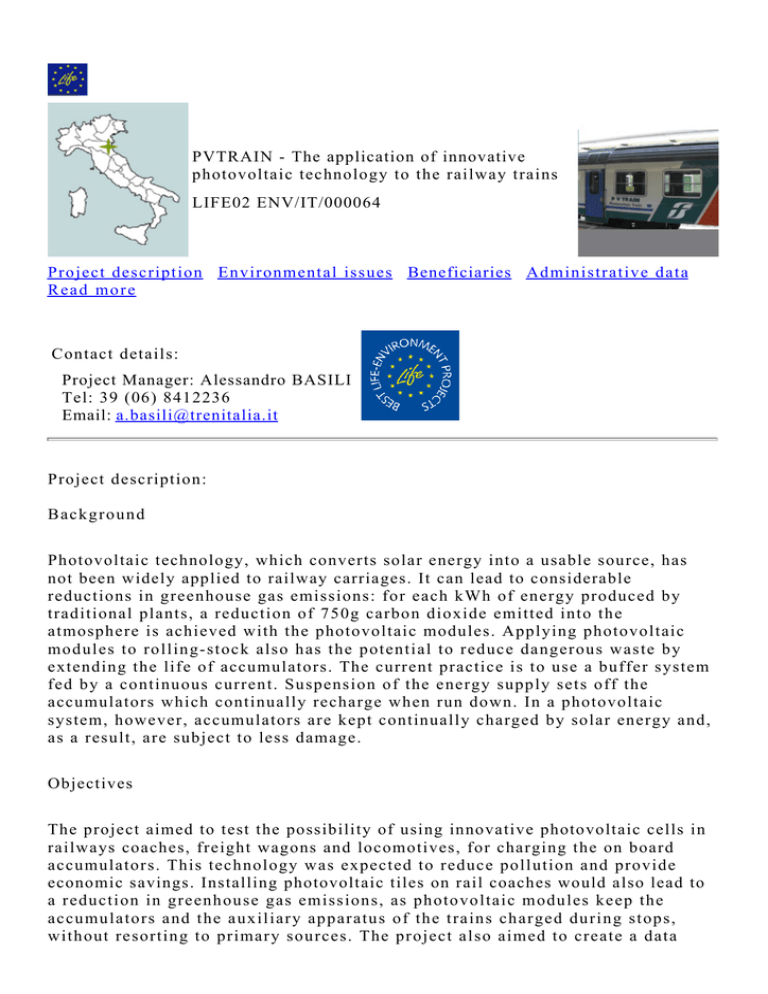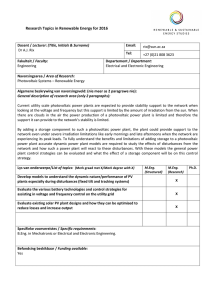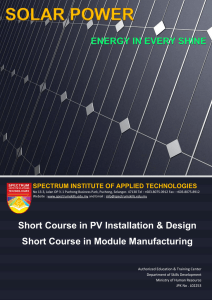PVTRAIN - The application of innovative photovoltaic technology to
advertisement

PVTRAIN - The application of innovative photovoltaic technology to the railway trains LIFE02 ENV/IT/000064 Project description Environmental issues Beneficiaries Administrative data R e a d m o r e Contact details: Project Manager: Alessandro BASILI Tel: 39 (06) 8412236 Email: a.basili@trenitalia.it Project description: Background Photovoltaic technology, which converts solar energy into a usable source, has not been widely applied to railway carriages. It can lead to considerable reductions in greenhouse gas emissions: for each kWh of energy produced by traditional plants, a reduction of 750g carbon dioxide emitted into the atmosphere is achieved with the photovoltaic modules. Applying photovoltaic modules to rolling-stock also has the potential to reduce dangerous waste by extending the life of accumulators. The current practice is to use a buffer system fed by a continuous current. Suspension of the energy supply sets off the accumulators which continually recharge when run down. In a photovoltaic system, however, accumulators are kept continually charged by solar energy and, as a result, are subject to less damage. Objectives The project aimed to test the possibility of using innovative photovoltaic cells in railways coaches, freight wagons and locomotives, for charging the on board accumulators. This technology was expected to reduce pollution and provide economic savings. Installing photovoltaic tiles on rail coaches would also lead to a reduction in greenhouse gas emissions, as photovoltaic modules keep the accumulators and the auxiliary apparatus of the trains charged during stops, without resorting to primary sources. The project also aimed to create a data bank for measuring the performances obtained in the tests. These results would bank for measuring the performances obtained in the tests. These results would be disseminated among various interest groups. Results The project beneficiary installed amorphous silicon type photovoltaic tiles on five passenger coaches and US 116 photovoltaic panels on two locomotives and three freight coaches. The photovoltaic modules can be attached to the curved surfaces of the coaches, locomotives and freight wagons and keep the on-board accumulators charged even during stops. As well as providing energy cost savings, the photovoltaic technologies offer two significant environmental advantages over non-renewable energy sources: • Less greenhouse gas production: The solar panels keep the accumulators and auxiliary devices in charge during the stops, without depending on the main electrical system, with a reduction of 750 gr. of carbon dioxide per KWh of produced energy compared to the traditional sources. • Longer lifespan of the accumulators: These are subjected to less wear and tear as a result of the photovoltaic cells being kept constantly charged. Longer lifecycles means less hazardous waste. The energy produced by the photovoltaic panels can have different uses: they can be applied to the coaches and locomotives to charge the accumulators for the lighting and air conditioning, and they can also be installed on the freight carriages to recharge the accumulators so as to ensure the power supply for electric locks used to protect transported goods. Trials were carried out on the whole system to assess its validity. Energy yields were shown to have improved in the testing period of June to September 2004 from the same period of the previous year, due to the streamlining of the capturing mechanism. The converter transforms the electric energy generated by the PV panels into electric energy suitable for the recharging of the batteries. For the observation period July 2003 to October 2005, the energy used by the prototype coach was 1378.42 kWh, resulting in a reduction of 1033.82 kg of CO2 emissions. Between August 2004 and October 2005, the energy used by the prototype locomotives was 159.3 KWh (sufficient to keep the on-board accumulators going), with a CO2 emissions reduction of 119.95 kg; the energy used by the prototype freight wagons was 540 KWh (sufficient for the electrical locks), resulting in a reduction of 405.51 kg of CO2 emissions. These results were disseminated to various interest groups and a database was built up. This project has been awarded the title of "Best of the Best" from a shortlist of 22 "Best" LIFE Environment projects in 2006-2007 Top Environmental issues addressed: Themes Services & Commerce - Transportation - Storage Energy - Supply Keywords Keywords rail transport‚ renewable energy Natura 2000 sites Not applicable Top Beneficiaries: Coordinator Type of organisation Description Partners TRENITALIA Public enterprise Trenitalia is the transport company of the Gruppo Ferrovie dello Stato, Italy's state railways group. None Top Administrative data: Project reference Duration Total budget EU contribution Project location LIFE02 ENV/IT/000064 01-NOV-2002 to 31-OCT -2005 1,252,972.00 € 616,111.00 € Lazio(Italia) Top Read more: Project web site Project web site Publication: Layman report Video feature Video link Webpage of the beneficiary Website of the beneficiary Title: Layman report Year: 2004 No of pages: 18 Title: Video feature of the project (15 MB) "Trenitalia: progetto PV Train" (5') Top Project description Environmental issues Beneficiaries Administrative data Project description Environmental issues Beneficiaries Administrative data R e a d m o r e




